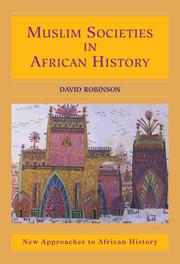Book contents
- Frontmatter
- Acknowledgments
- Contents
- LIST OF MAPS AND FIGURES
- INTRODUCTION
- PART I The Historical and Institutional Background
- PART II General Themes
- PART III Case Studies
- 7 Morocco: Muslims in a “Muslim Nation”
- 8 Ethiopia: Muslims in a “Christian Nation”
- 9 Asante and Kumasi: A Muslim Minority in a “Sea of Paganism”
- 10 Sokoto and Hausaland: Jihad within the Dar al-Islam
- 11 Buganda: Religious Competition for the Kingdom
- 12 The Sudan: The Mahdi and Khalifa amid Competing Imperialisms
- 13 Senegal: Bamba and the Murids under French Colonial Rule
- CONCLUSION
- GLOSSARY
- INDEX
8 - Ethiopia: Muslims in a “Christian Nation”
Published online by Cambridge University Press: 05 June 2012
- Frontmatter
- Acknowledgments
- Contents
- LIST OF MAPS AND FIGURES
- INTRODUCTION
- PART I The Historical and Institutional Background
- PART II General Themes
- PART III Case Studies
- 7 Morocco: Muslims in a “Muslim Nation”
- 8 Ethiopia: Muslims in a “Christian Nation”
- 9 Asante and Kumasi: A Muslim Minority in a “Sea of Paganism”
- 10 Sokoto and Hausaland: Jihad within the Dar al-Islam
- 11 Buganda: Religious Competition for the Kingdom
- 12 The Sudan: The Mahdi and Khalifa amid Competing Imperialisms
- 13 Senegal: Bamba and the Murids under French Colonial Rule
- CONCLUSION
- GLOSSARY
- INDEX
Summary
Another area of Africa with an old regional identity is Ethiopia. Not so much the Ethiopia of the twentieth century, which comprised most of the horn of Africa, but the mountainous zones of the north and west, which have high rainfall and form the main watersheds of the Nile River. This smaller zone is sometimes called Abyssinia (“Habash” for Arabic speakers living in the Middle East).
In this instance the associated religious identity is Christian, not Muslim. For centuries Middle Eastern, Mediterranean, and European people have ascribed a Christian identity to the area. Ethiopia was often associated with the Prester John of medieval legend, the Christian kingdom that lived “behind” the lands of Islam and would join with European Christians in a world crusade, as discussed in Chapter 6. This ascription was not completely erroneous, for since the fourth century some Ethiopians have been Christian, in the form of the Ethiopian Orthodox Church, and have been writing chronicles and letters to communicate that identity.
More recently the army of Ethiopia won a signal victory against European invaders and thereby guarded their independence, whereas the rest of Africa was coming under colonial rule. Emperor Menilik's triumph over the Italians at Adwa in 1896 won him undying fame in Africa and the African diaspora and helped to diffuse the association of Ethiopia and Christianity throughout the world. So we find “Ethiopian” Christian churches, usually constituted by Africans and African Americans, all over the globe today.
- Type
- Chapter
- Information
- Muslim Societies in African History , pp. 108 - 123Publisher: Cambridge University PressPrint publication year: 2004

